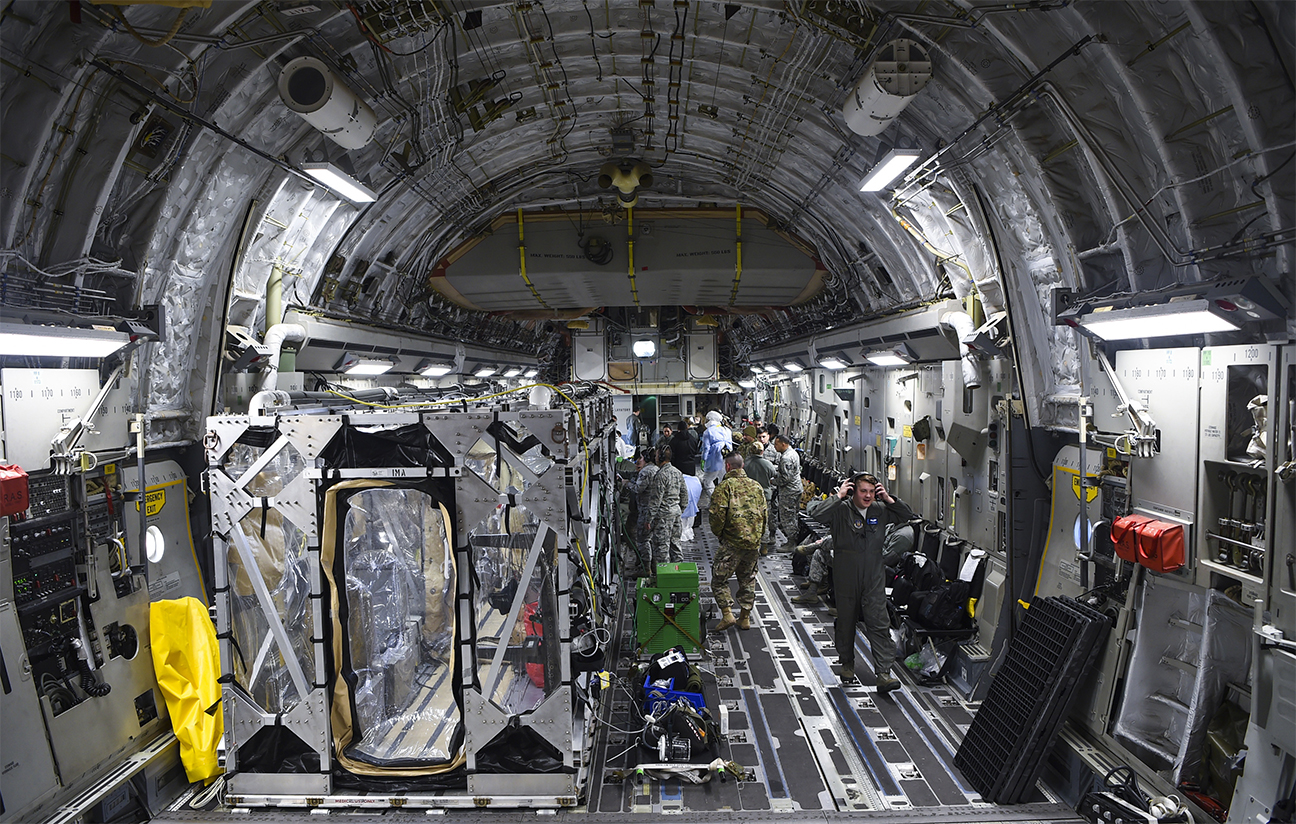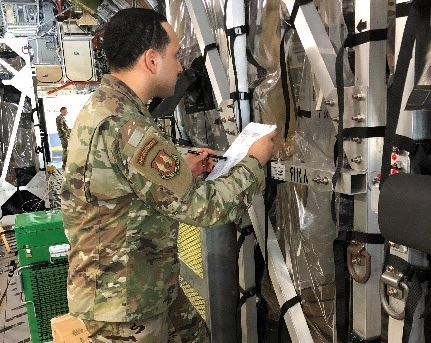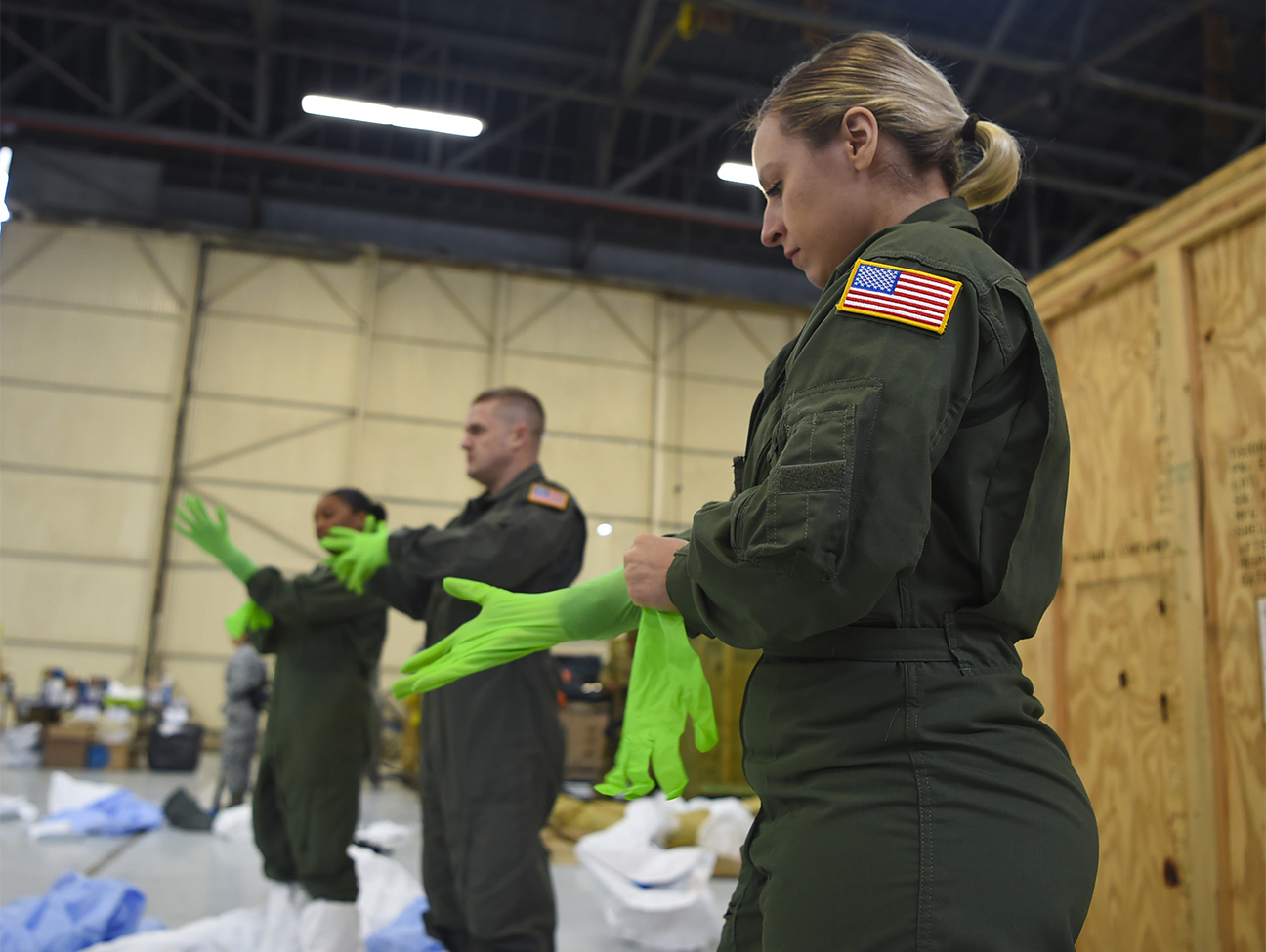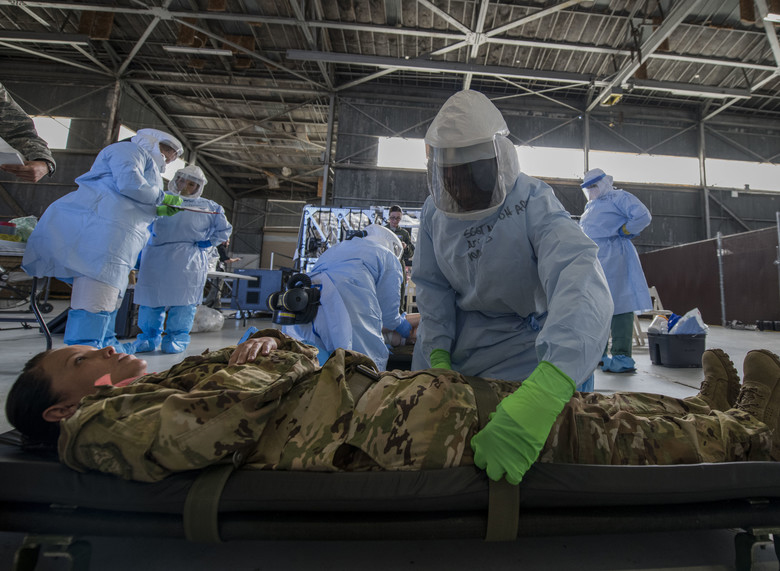Bring Them Home: USAFSAM trains teams to treat, transport COVID-19 patients
JOINT BASE CHARLESTON, S.C. – Medical professionals from the United States Air Force School of Aerospace Medicine are training medics here on the use of the Transport Isolation System to move patients affected by COVID-19 aboard military cargo aircraft.
The TIS is an infectious disease containment unit designed to minimize risk to aircrew and medical attendants, while allowing in-flight medical care for patients afflicted by contagions like COVID-19. The TIS represents an important tool in Air Mobility Command’s COVID-19 response to safely transport patients afflicted by the virus.
“Right now, in the midst of this global pandemic, we have forces in harm’s way around the world,” explained Col. Leslie Wood, USAF Air Mobility Command en route care medical director. “Because of the requirements of transporting personnel with infectious disease like COVID-19, we can’t use our traditional methods of transport without risking the medical crew in the back of the plane, and the rest of the crew in the front. And if we lose these crews, we lose operational capability.”
Training medical personnel on biocontainment care is the day-to-day job of both Lt. Col. Elizabeth Schnaubelt and Tech. Sgt. Victor Kipping-Cordoba back in Nebraska.
Schnaubelt, USAFSAM infectious disease physician, and Kipping-Cordoba, USAFSAM public health technician, both work at the school house’s youngest Center of Sustainment of Trauma Readiness Skills location in Omaha at the University of Nebraska Medical Center. Schnaubelt is the C-STARS Omaha director; Kipping-Cordoba, the non-commissioned officer in charge. USAFSAM is headquartered at Wright-Patterson Air Force Base in Dayton, Ohio, and nested within the Air Force Research Laboratory’s 711th Human Performance Wing.
The two experts were initially called to help with this AMC mission because of their expertise with infectious diseases and public health, and their expertise with Ebola. But now, this pair has been asked to answer another national call – ensuring this necessary training on TIS to ensure patient safety and operational readiness in the fight against COVID-19.
“We’ve been working closely with AMC on TIS training,” explained Schnaubelt. “It’s now being adapted for care and transport of patients with COVID-19. We’re here to help make those modifications. We’ve been fully integrated with Nebraska’s COVID-19 response. Tech. Sgt. Kipping and I are bringing a lot of those lessons learned from the medical center, and adapting them to this mission of transporting patients with this highly infectious virus.”
What makes the expertise at C-STARS Omaha unique to the current COVID-19 pandemic is that this team focuses on advancing the readiness skills and competency of USAF medical personnel who provide safe and effective care for patients who have contracted or may have been exposed to highly hazardous infectious diseases. USAF medical personnel are trained at C-STARS Omaha to care for patients with diseases like the Ebola virus, and now, COVID-19.
The training, Kipping-Cordoba explained, is normally three days.
“We train on personal protective equipment donning and doffing procedures followed by waste management procedures and equipment familiarization and inventory,” said Kipping-Cordoba.
“During the training, the infectious disease team leads the disease and infection prevention and control briefings, all PPE donning and doffing and providing infection prevention and control, clinical guidance, and risk management,” he said.
First implemented after the Ebola virus outbreak in 2014, the TIS was engineered to ensure patients get the proper treatment in the event they become infected with any contagious disease during missions to affected areas, according to a news release from the Air Force Medical Service.
“We initially started the TIS program thinking of Ebola–and that was likely to be a 1 to 2 patient movement. Very low volume of patients,” explained Wood. “So right now, we’re shifting that response completely to adapt to higher volume transport and more enduring yield – so over the next several months as opposed to shorter durations.”
While Wood explained that there are not many trained to work with TIS, they are on their way.
“We have crews inbound and ready to be trained up to support the additional TIS units that we are putting online as we speak—all in order to stand up a larger-volume response to this pandemic,” said Wood. “Responding to this pandemic is a whole-of-government effort, so while we’re currently planning for our military forces, we understand that we could be asked by our senior leaders to move American citizens from around the world who might be stranded due to COVID-19. I’ll speak for all of us by saying—we stand ready.”
Click here for more COVID-19 information.

A U.S. Air Force C-17 Globemaster III is prepped to transport a transportation isolation system March 6, 2019, during a training exercise that allows Airmen to practice the most effective and safest form of transportation for patients and their medical professionals. Engineered and implemented after the Ebola virus outbreak in 2014, the TIS is an enclosure the Department of Defense can use to safely transport patients with highly contagious diseases. (U.S. Air Force photo by Senior Airman Cody R. Miller)

Tech. Sgt. Victor Kipping-Cordoba stands outside a Transport Isolation System (TIS) and provides instruction to an aeromedical evacuation member inside during a training session at Joint Base Charleston March 27, 2020. Kipping-Cordoba and others are training other medical professionals to use the TIS to safely transport patients with highly contagious diseases. (U.S. Air Force photo by Lt. Col. Elizabeth Schnaubelt)

U.S. Air Force Staff Sgt. Laura Mendoza dons her personal protection equipment March 5, 2019, during transportation isolation system training at Joint Base Charleston, S.C. Mendoza is a respiratory therapist from the 60th Surgical Operations Squadron at Travis Air Force Base, Calif. Engineered and implemented after the Ebola virus outbreak in 2014, the TIS is an enclosure the Department of Defense can use to safely transport patients with highly contagious diseases. (U.S. Air Force photo by Senior Airman Cody R. Miller)

Staff Sgt. Lee Nembhard, an aeromedical evacuation technician assigned to the 375th Aeromedical Evacuation Squadron from Scott Air Force Base, Ill., straps a simulated Ebola patient to a litter during a Transport Isolation System training exercise at Joint Base Charleston, S.C., October 23, 2019. The TIS is a device used to transport Ebola patients, either by C-17 Globemaster III or C-130 Hercules, while preventing the spread of disease to medical personnel and aircrews until the patient can get to one of three designated hospitals in the United States that can treat Ebola patients. JB Charleston is currently the only military installation with a TIS. The TIS mission is a sub-specialty of the aeromedical evacuation mission which requires frequent training to maintain readiness.

Flight nurses and critical care air transport team members assigned to the 43rd Aeromedical Evacuation Squadron from Pope Army Air Field, N.C., and 375th AES from Scott Air Force Base, Ill., prepare a Transport Isolation System for simulated Ebola patients during a TIS training exercise at Joint Base Charleston, S.C., October 23, 2019. The TIS is a device used to transport Ebola patients, either by C-17 Globemaster III or C-130 Hercules, while preventing the spread of disease to medical personnel and aircrews until the patient can get to one of three designated hospitals in the United States that can treat Ebola patients. JB Charleston is currently the only military installation with a TIS. The TIS mission is a sub-specialty of the aeromedical evacuation mission which requires frequent training to maintain readiness.
